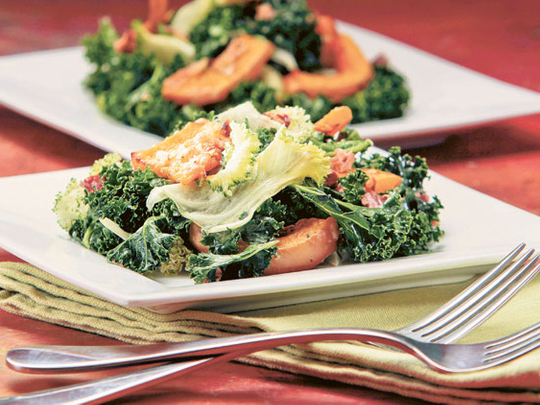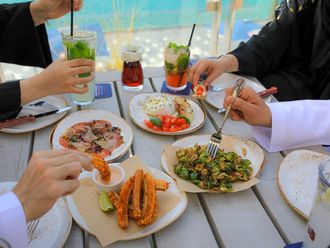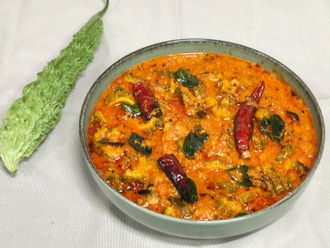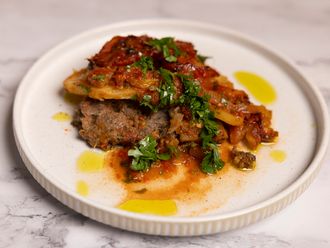
Kale is about as unlikely a food star as you can imagine. It's tough and fibrous. Bite a piece of raw kale and you'll practically end up with splinters between your teeth. Nevertheless, kale has become a green of the moment because, given a little special care, it actually can be made not only edible but delicious.
You can cook it, of course — the lower and slower, the better. But surprisingly, one of the most popular ways to use kale these days is in salads. Though kale leaves have always been found on almost every salad bar, it wasn't for reasons of edibility — it was for decoration, because this was one green so tough it would last for ever without wilting. But the solution is remarkably simple: Give it a massage. Yes, seriously. And I mean a real massage — a deep-tissue bone-breaker. Grab bunches of it in both hands and squeeze. Then rub them together. And repeat. It's almost like kneading bread dough. It won't take very long — just a couple of minutes — but you'll be amazed at the difference.
That tough cellulose structure breaks down — wilts, actually — and those leaves that once seemed so coarse and fibrous turn silky. You can feel it happening. You can see it too — the leaves will darken and shrink to almost half their pre-massage volume. The flavour changes as well. That pronounced bitterness mellows, revealing some of the same depths of sweet green flavour you normally get only through long, slow cooking.
Take a bite
In fact, the best way to know when you've massaged kale long enough is to take a bite.
The colour and texture changes can happen before the leaves are completely softened. But taste doesn't lie.
Even better, because the massaged greens have such a wonderful texture and just the right mix of sweet and bitter flavour, you don't need much of a salad dressing.
Use a little good olive oil and a pinch of salt when you are giving it a rubdown, and all you will need afterwards is a hint of acidity — vinegar or lemon juice — to make that perfectly balanced salad.
KALE SALAD WITH FARRO, DRIED FRUIT AND BLUE CHEESE
- 1/4 cup farro
- Water
- Salt
- 1/4 cup dried fruit, mixed (such as sour cherries, cranberries and raisins)
- 1 tsp orange essence
- 450g kale
- 1 tbs olive oil
- 1/4 cup blue cheese, crumbled
- 2 tbs red onion, minced
- 2 tbs pecans, chopped and toasted
- 2 tsp vinegar
- Pepper, freshly ground, to taste
Toast the farro in a dry medium saucepan over medium heat until it smells nutty and turns golden, about five minutes. Add 2 cups water and bring to a simmer. Season with one-half teaspoon salt and cook until the farro is tender but still a little chewy, about 45 minutes. Drain (there will probably still be some liquid left), rinse under cold running water and gently pat dry in a kitchen towel.
Place the dried fruit in a small bowl with the orange essence. Add just enough warm water to cover and set aside until softened, about 15 minutes. Alternatively, you can microwave them for 30 seconds and let stand for 5 minutes. Remove and discard the stems from the kale. Chop the leaves into bite-sized pieces. Place in a large mixing bowl with 1 teaspoon salt and the olive oil. Grab the leaves by the handfuls and massage them roughly. Don't be timid. After a minute or two, the coarse, stiff leaves will turn soft and silky. You'll have about half the volume of kale you started with. Drain the dried fruit and add it to the kale, along with the cooked farro, blue cheese, red onion, pecans and vinegar. Toss to mix well, then season to taste with black pepper and more salt and vinegar, if necessary.
Nutrition per serving: 127 calories; 4g protein; 16g carbohydrates; 3g fibre; 6g fat; 2g saturated fat; 4mg cholesterol; 5g sugar; and 688mg sodium.
Total time: 1 hour
Servings: 4 to 6
KALE SALAD WITH ROASTED WINTER SQUASH
- 1 pound section of butternut squash, unpeeled (preferably the thinner neck)
- Olive oil
- 2-1/2 tsp garlic, minced
- 1/2 tsp thyme, minced and fresh
- Salt
- 1 ounce Parmigiano-Reggiano, grated
- 1 pound kale
- 1 tsp vinegar
- 1/4 cup walnuts, chopped and toasted
Heat the oven to 400 degrees. Cut the butternut squash lengthwise into quarters, then seed and remove any of the stringy centre. Cut the pieces crosswise into slices a little thicker than one-fourth inch. Place the squash in a large mixing bowl and add 2 tablespoons olive oil, the garlic, the thyme and 1 teaspoon salt. Toss to coat well. Add the Parmigiano-Reggiano and toss again. Line a jellyroll pan with metal foil and scatter the squash wedges in a single layer. Roast until the squash is tender, fragrant and lightly browned, about 20 minutes. Remove from the oven and set aside to cool. Remove and discard the stems from the kale. Chop the leaves into bite-sized pieces. Place in a large mixing bowl with 1 teaspoon salt and 1 tablespoon olive oil. Massage leaves until they turn soft and silky. Add the sherry vinegar and toss well. Season to taste with more salt and vinegar if necessary. Arrange the greens in a low mound on individual serving plates or on a platter. Scatter the cooled squash pieces over the top. Sprinkle with chopped walnuts and serve.
Nutrition per serving: 109 calories; 3g protein; 14g carbohydrates; 3g fibre; 5g fat; 1g saturated fat; 4mg cholesterol; 3g sugar; 829mg sodium.
Total time: 50 minutes, plus cooling time for the squash
Servings: 4 to 6
— Los Angeles Times
















